
Port Talbot is a town and community in the county borough of Neath Port Talbot, Wales, situated on the east side of Swansea Bay, approximately eight miles from Swansea. The Port Talbot Steelworks covers a large area of land which dominates the south east of the town. It is one of the biggest steelworks in the world, but has been under threat of closure since the 1980s. The population was 31,550 in 2021, comprising about a fifth of the 141,931 population of Neath Port Talbot.

Briton Ferry is a town and community in the county borough of Neath Port Talbot, Wales. The Welsh name may indicate that the church, llan, is protected from the wind, awel. Alternatively, Sawel may be a derivative of Saul, St Paul's earlier name. He once landed at Briton Ferry. An alternative Welsh name unused today is Rhyd y Brython, a direct translation of Briton Ferry. The Normans referred to the River crossing as La Brittonne and Leland in 1540 as Britanne Fery.

Port Talbot Parkway railway station is a railway station in Port Talbot, Wales. The station is located at street level near Station Road in Port Talbot town centre. It is 202 miles 59 chains (326 km) from London Paddington.
The Garw Valley Railway is the trading name of the Bridgend Valleys Railway Company Limited. It operates a short section of 4 ft 8+1⁄2 instandard gauge railway located in South Wales, which is being recreated as a heritage railway. Formerly part of the Llynvi and Ogmore Railway (L&OR) and built by the Great Western Railway (GWR), the line was used for freight and passenger services, with most of the track still in place between Brynmenyn and Pontycymer. The project currently has a train shed at Pontycymer, and hopes to initially offer brake van rides between Pontycymer and Pant-y-Gog, a distance of 0.5 miles (0.8 km).
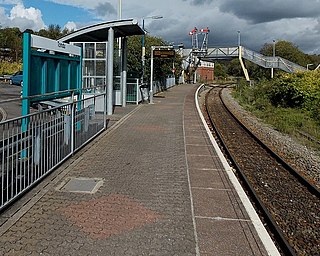
Tondu railway station is a railway station serving the village of Tondu, Bridgend county borough, South Wales. It is located on the Maesteg Line from Cardiff via Bridgend.

Port Talbot Steelworks is an integrated steel production plant in Port Talbot, Wales, capable of producing nearly 5 million tonnes of steel slab per annum. This makes it the larger of the two major steel plants in the United Kingdom and one of the largest in Europe. Over 4,000 people work at the plant.

Teesport is a large sea port located in the unitary authority of Redcar and Cleveland, in the ceremonial county of North Yorkshire, Northern England.
Margam TMD was a railway locomotive traction maintenance depot situated in Port Talbot, South Wales. The depot code was MG, which has now been re-allocated to Margam Knuckle Yard service point.
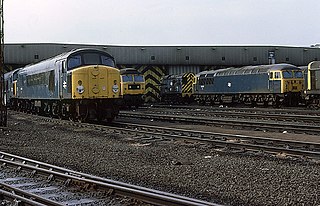
Toton Traction Maintenance Depot or Toton Sidings is a large traction maintenance depot located in Toton, Nottinghamshire. The TOPS depot code for the depot is TO. Before TOPS, the shed code was 16A.

Round Oak Steel Terminal is a railway freight terminal dealing in steel from the Round Oak Steel Works until 1982 and from other sources thereafter, in Brierley Hill, West Midlands, England managed by Tata Steel Europe.
In 1861 the Llynvi Valley Railway was opened in Glamorganshire, Wales, to convey mineral products to the Bristol Channel at Porthcawl. It adopted an earlier tramroad, the Duffryn Llynvi and Porthcawl Railway. The Llynvi and Ogmore Railway was opened in 1865, and the two companies amalgamated to form the Llynvi and Ogmore Railway in 1866. At first Porthcawl harbour was an important destination for onward transport, but this soon declined.
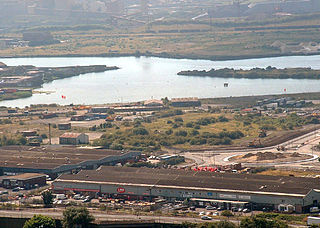
The Port of Port Talbot is located on the River Afan estuary next to Port Talbot Steelworks in the industrial town of Port Talbot, South Wales. The whole basin complex covers about 500 acres (2.0 km2), consisting of: an inner set of floating docks, developed from 1834 onwards; and an outer tidal basin, completed in 1970. Owned and operated by Associated British Ports, the tidal basin has the deepest berthing facilities in the Severn estuary and is one of only a few harbours in the UK capable of handling Capesize vessels of up to 170,000 tonnes deadweight (DWT), mostly for the import of iron ore and coal for use by nearby Port Talbot Steelworks.
The Rhondda and Swansea Bay Railway was a Welsh railway company formed to connect the upper end of the Rhondda Fawr with Swansea, with the chief objective of transporting coal and other minerals to Swansea docks. It was incorporated in 1882, but at first the connection to Swansea from Briton Ferry was refused.
The Port Talbot Railway and Docks Company (PTR&D) was formed in 1894 to secure the means of bringing minerals, chiefly coal, to the harbour in South Wales. It took over the docks at Port Talbot that had been operated by the Port Talbot Company. It opened its main line in 1897 and reached a connection with the Great Western Railway Garw Valley line the following year. A branch line to collieries near Tonmawr also opened in 1898. The lines were extremely steeply graded and operation was difficult and expensive, but the company was successful. Passenger operation on the main line started in 1898, but this was never a principal part of the business. For some time most of the passenger train service was operated by a railmotor that was the largest ever to work in the United Kingdom. Also in 1898 the Ogmore Valleys Extension (OVE) line, a part of the PTR&D, was opened. It had been projected as a defensive measure against competitive incursion, and it led from Margam Junction towards Tondu.

The Eisenbahn und Häfen GmbH is a service company providing rail transportation and associated storage as well as operating the Rhine ports of Schwelgern and Walsum-Süd.

Llanwern steelworks is located in Llanwern, east of the City of Newport, South Wales.
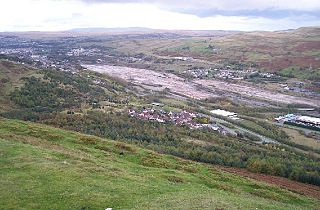
Ebbw Vale Steelworks was an integrated steel mill located in Ebbw Vale, South Wales. Developed from 1790, by the late 1930s it had become the largest steel mill in Europe. It was nationalised after World War II. As the steel industry changed to bulk handling, iron and steel making was ceased in the 1970s, and the site was redeveloped as a specialised tinplate works. It was closed by Corus in 2002, but is being redeveloped in a joint partnership between Blaenau Gwent Council and the Welsh Government.

Trostre Steelworks is a tinplate manufacturing facility located in Pemberton, Carmarthenshire, just outside Llanelli, West Wales. Planned by the Steel Company of Wales in 1947, today it is part of Tata Steel Europe's infrastructure.
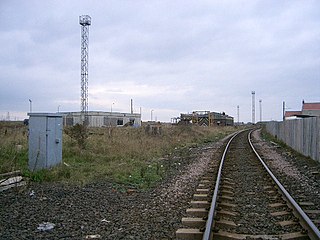
Blyth Cambois TMD was a traction maintenance depot located in Blyth, Northumberland, England. The depot was situated on the west side of the branch line from Bedlington Junction to Blyth Docks.

Redcar Bulk Terminal (RBT), also known as Redcar Ore Terminal, is a privately run dock at the mouth of the Tees Estuary in North Yorkshire, England. The port is used for the transhipment of coal and coke and for many years was the import dock for iron ore destined for Redcar Steelworks under British Steel Corporation, British Steel plc, Corus, Tata Steel Europe and Sahaviriya Steel Industries.




















